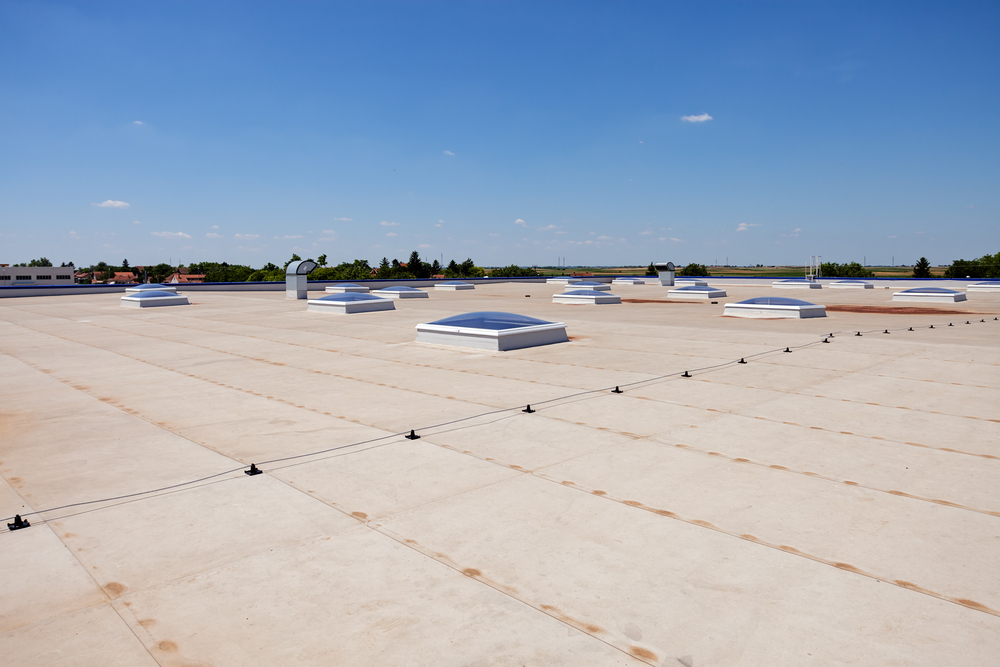
Choosing the right material for a new roof isn’t as easy as some may think, especially for commercial building owners. Residential is tough as it is, but commercial buildings make it even harder due to the vast amount of options that are offered. It is important to know the ins and outs with each type of roofing material, so that the best decision can be made for each particular project. Here’s a list of different types of popular commercial roofing materials:
- Acrylic Coatings
- Asphalt Rolls
- Ethylene Propylene Diene Monomer (EPDM)
- Polyvinyl Chloride (PVC)
- Spray Polyurethane Foam (SPF)
- Thermoplastic Polyolefin (TPO)
Acrylic Coatings
Acrylic Roof Coatings are most known for being the preferred option if you aren’t going for an actual replacement. This is for good reason – if done properly and maintained the right way, it can easily last as long as some of the others on the list. In order to do this properly, you need a primer, a base coat, fabric, more base coat on top of the fabric, and then a final top coat. What you end up with is a strong layer of reliable roofing that can withstand even heavy hail.
PROS:
- Balance between cost and performance
- Easy repair: usually just caulk
- UV resistant and reflective
- End of life hack: simply adding another layer of topcoat could add up to two decades to it
CONS:
- Can be prone to lose mil thickness with weather factors
- Has to be applied when temperature is 50 degrees or higher
- Pondering water issues can hurt performance: flat roofs might need depressed areas worked on prior to installation
Asphalt Rolls
This is one that is a popular option for residential properties. It is made of the same materials used in asphalt shingles. It is usually used with low-slope roofs.
PROS:
- Very inexpensive roofing type
- Easy installation compared to other types
CONS:
- Short life expectancy: around 10 years
- Maintenance and repairs are higher than others: since it is rolled out and put together at seams, lots of problems develop at those seams
- Not very energy efficient
Ethylene Propylene Diene Monomer (EPDM)
Since the name is so hard to say, it is commonly known as rubber roofing.
PROS:
- Price: one of the most inexpensive materials out there
- Easy installation
- Very lightweight: roof does not have to be reinforced
- Fairly long life-expectancy: up to 20 years if done properly
- Not easily damaged by UV rays
CONS:
- Aesthetics: not the best-looking roof
- Can cause stress on AC systems due to the black color absorbing the heat; can come in lighter colors, but hikes up cost for you
- Puncture prone: branch, hailstorm, etc.
- Adhesives used to bond seams: there are longer-lasting methods available in other types
- Can be tough to track down origin of leaks because water can travel underneath layer and go all over
Polyvinyl Chloride (PVC)
This type of roofing has two layers of material with polyester being laid in between them. This adds a layer of reinforcement. Along with this, the layers include additives that help with UV-stability and flexibility.
PROS:
- Fairly long lifespan compared to others
- Durable
- Fire, wind, chemical, and moisture resistant
- Heat welding installation process: keeps seams secure
CONS:
- Expensive
- Can shrink over time which can cause leaks due to seams pulling and corners lifting
- Cold weather can cause older PVC roofs to shatter or puncture
- Difficult repair: the heat welding used in newer roofs does not react well with older roofs
Spray Polyurethane Foam (SPF)
This type of roofing is very interesting. It is made from plastic that is sprayed out as a liquid that turns into a solid in a matter of seconds. What is really neat about this is that it actually expands to around 30 times its size as it dries.
PROS:
- Energy-efficient: sustainable when talking about energy savings
- Multi-layer system (adding acrylic roof coating over the foam) is very durable
- Long lifespan: when taken care of properly, can last 40 years or more
- Seals very well due to its expansive nature making it reliable against leaks
- Versatile: self-curbs around lumps and can be used to create water channels to drains
CONS:
- Very difficult installation process: if not done properly, it will not last; can take a contractor a long time to master the process
- Difficult and expensive to remove
Thermoplastic Polyolefin Roof (TPO)
Thermoplastic Polyolefin Roofing or TPO has become a popular choice for commercial buildings. It is very similar to PVC so they are compared together often.
PROS:
- Inexpensive type of roofing; usually even less expensive than EPDM or rubber roofing
- Reduces heat build-up: white color helps reflect the sun’s rays
- Light weight
- Installation variety: directly fastened to deck or adhered to deck
- Easy maintenance: resistant to corrosion, algae and mildew free, and does not require pressure washing
- Heat-welded seams help to create more reliable bond to limit potential for leaks
CONS:
- Questionable quality out there: make sure it is from a prominent manufacturer
- Top layer is laminated which can cause cracking, shrinking, and deterioration at some points
- Comes in small widths: lots of seams create potential for more problems
- Not fire-resistant
If you are looking to replace or secure a new roof for your commercial property, it’s important to consult with an experienced roofing expert to determine the most cost-effective and reliable roofing system for your needs.


